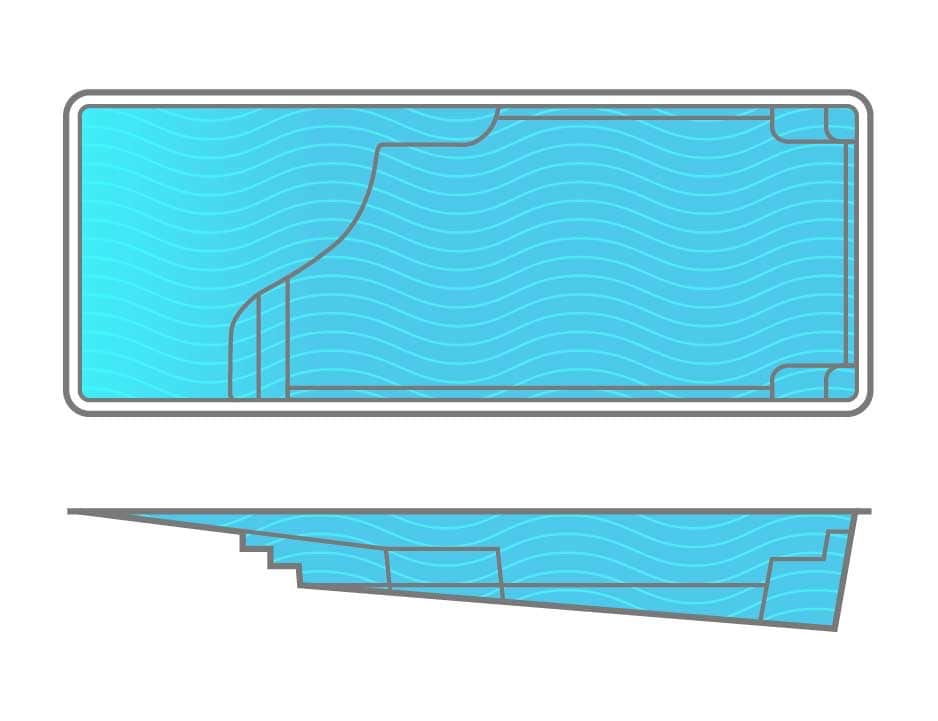Five Problems With Beach Entry Fiberglass Pools

Finding the right inground pool design for your backyard can be exciting and challenging. You have a lot of options, not just between the pool types (fiberglass, concrete pools, vinyl liner pools), but between shapes and designs as well.
Do you want a Roman-shaped pool? Perhaps a freeform pool? Maybe the classic rectangle is perfect for you. Perhaps more importantly is what style of pool would best compliment your backyard? That could be a smaller plunge pool. Maybe it’s a kidney-shaped pool?
You hear the words “backyard oasis” a lot in the world of inground pools, and for good reason. An inground pool project, complimented by landscaping and a new backyard design can completely transform a backyard.
A beach is great, but a beach in your backyard is even better. Beach entry inground pools have been available with concrete inground pool construction for a long time, but they only recently became available in fiberglass pools.
Beach entry fiberglass pools are an incredible invention. The speed of fiberglass pool construction can give you a backyard beach in four weeks.
Like any product of its kind, beach entry fiberglass pools are not without their problems, which is what we’re going to discuss in this article. What are the top five problems with beach entry fiberglass pools? Let’s dive in.
Entry Discoloration

The beach entry section of a fiberglass pool sits in shallow water. Because of this, it is constantly exposed to both sunlight and fluctuating water chemistry. Over time, this can cause fading or discoloration in the gelcoat finish near the shallow beach entry.
Maintaining balanced pool water chemistry and using high-quality cleaning agents can help, but the shallow slope will always be more vulnerable to UV and chemical exposure than deeper areas.
Regular pool maintenance of the area, as well as keeping the pool covered from harsh weather, is essential to preserve the color and shine of your entry surface.
Water Seepage Under Cover
If you plan on purchasing an automatic pool cover, be aware that beach entry fiberglass pools can make sealing the cover difficult.
Because the pool floor gradually slopes upward, the cover can’t create a perfect seal along the entry line. During rainfall, rainwater may seep under the cover and into the pool water.
Rainwater is acidic, meaning that it will lower the pH of your pool water, possibly lowering the effectiveness of your chlorine.
Debris and Animals Under Cover
That same shallow, open entryway can also become a mess of leaves, twigs, and even small animals if your pool isn’t properly covered or maintained.
Unlike a standard pool ledge or step area, the large open slope of a beach entry pool, parts of which are sometimes exposed to the elements, provides more surface area for debris to collect. This means you’ll likely spend more time skimming and cleaning the entry zone, which is already an important factor in your ongoing beach entry pool maintenance routine.
Limited Coping Options Near Entry
Inground pool construction around a beach entry requires precision. The gradual slope of the fiberglass shell leaves less room for traditional pool coping or decorative concrete borders near the entry.
This limits some of the coping options homeowners usually enjoy, such as raised paver coping or decorative tile edges. Installers must also be cautious to ensure that any decking material transitions smoothly with the fiberglass entry to prevent trip hazards or uneven surfaces.
Lighting Problems
Lighting can be tricky in beach entry designs. Because the slope is shallow and quite wide, underwater lights struggle to properly illuminate the entry area. This can create dark spots or uneven lighting patterns at night. Additional lighting around the pool deck or under-lip LED strips can help, but they add cost and additional labor to your inground pool construction plan.
Conclusion
If you’re considering an inground fiberglass beach entry pool, be sure to research swimming pool contractors in your area that can install these unique pools. Make sure to ask them about the problems inherent with beach entry fiberglass pools. An honest and transparent pool contractor is always the one you want to go with.
Beach entry fiberglass pools are a beautiful product that can offer a durable, long-lasting swimming experience. You should be aware of the problems with them so you can make an educated buying choice.
For more information about beach entry fiberglass pools, check out the articles below. For more educational content on all things pools and landscaping, check out our learning hub at the top of our page. Thank you for reading.
Fiberglass Pool Maintenance: How To Master Your Pool
Top 5 Fiberglass Manufacturers of 2025
Written by Logan Edgemon
